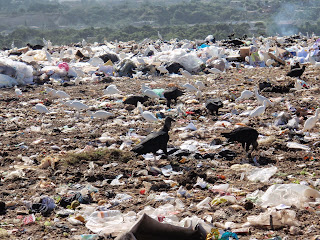Greetings, all! I like many of our murderous crew am heading to Bouchercon in Long Beach shortly. This is a post I wrote in 2008, about a visit to the old Puerto Vallarta dump. I was researching the novel that would become "Getaway" at the time, and though I didn't know how or why I might feature a dump, I had an idea that it would make a great setting for a noir thriller. The dump ended up being prominently featured, and I like to think I did right by its potential. Now I'm working on the sequel to that book and thought it would be a good time to revisit Mexico, as opposed to China. Even though the "Getaway" sequel is set in the exotic USA...
(as always, click to embiggen)
Valeria has done some work at the dump, both as a volunteer and a performance artist. She graciously agreed to take me. But she couldn't get the necessary permit, even trying a few days in advance. The situation at the dump is complicated. It's scheduled to close, but delays in completing the new dump mean that the old one will remain open a little longer.
The dump is 28 years old. It began at a time when there were no real environmental regulations in Mexico, in a valley some distance from the town. Trash piled up in the valley until the valley filled; then the mountain rose above it. Gradually the town came as well. There are new apartments close to the dump, and a new university too.
At first the manager didn't want to let us up there. He wanted to be assured that I wouldn't say anything bad about the dump. I promised I wouldn't, and that if he didn't want me to take photos, I would not.
He took us up in his pickup, on paths blocked at times with baby carriages and cracked tires, up to the top. The lower levels of the mountain have been covered with grass, which I believe is planted on top of a rubber membrane, again designed to seal off any contaminates from the dump. Once the manager determined that I was actually interested in how the dump worked, he explained it all to me. I understood most, but not all of what he had to say. What I did understand was his real passion and conscientiousness about his job, which was basically trying to retrofit a mountain of garbage so that the environment would be protected and the land eventually used for something else. But how? For years, the garbage had been sorted by hand; they have no real way of knowing what is buried there, how dangerous it might be. Methane gas accumulates; organic materials decompose into a viscous liquid that seeps wherever it can find a path.
The views from the top of the dump are pretty amazing. You can see the town, the marina, the new developments, the ocean. But the dump itself is what's really compelling.
The surface of the mountain is spongy; it trembles when the bulldozers come close. I wish I could describe the smell. Rancid, sweet, rotting fruit, spoiled baby food, shit — none of that quite captures it.
Meanwhile, the gleaners, the jovenes — all of the workers are jovenes, whether they are young, old, male or female, continue their labors: sorting through trash, through garbage, looking for things that they can sell. Cardboard. Bottles. Cans. Refrigerator parts. Copper wire. It's not much of a living; the price of recyclables has collapsed along with everything else in the current economic crisis.
























No comments:
Post a Comment